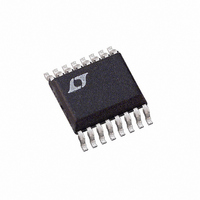LTC1730EGN-4 Linear Technology, LTC1730EGN-4 Datasheet - Page 9

LTC1730EGN-4
Manufacturer Part Number
LTC1730EGN-4
Description
IC BATT PULSE CHRGR LI-ION16SSOP
Manufacturer
Linear Technology
Datasheet
1.LTC1730ES8-4.2PBF.pdf
(12 pages)
Specifications of LTC1730EGN-4
Function
Charge Management
Battery Type
Lithium-Ion (Li-Ion)
Voltage - Supply
4.5 V ~ 12 V
Operating Temperature
-40°C ~ 85°C
Mounting Type
Surface Mount
Package / Case
16-SSOP (0.150", 3.90mm Width)
Lead Free Status / RoHS Status
Contains lead / RoHS non-compliant
Available stocks
Company
Part Number
Manufacturer
Quantity
Price
Company:
Part Number:
LTC1730EGN-4
Manufacturer:
LT
Quantity:
10 000
Part Number:
LTC1730EGN-4
Manufacturer:
LINEAR/凌特
Quantity:
20 000
APPLICATIO S I FOR ATIO
End-of-Charge (C/10)
The LTC1730 includes a comparator to monitor the duty
cycle at the GATE pin to detect a near end-of-charge
condition. When the duty cycle falls below 10%, the
comparator trips and turns off the N-MOSFET at the CHRG
pin and switches in a weak (40 A) current source to
ground. The end-of-charge comparator is disabled in
trickle charge mode.
Internal Pass Transistor
An N-channel MOSFET (0.35 ) is included in the LTC1730
as the pass transistor. The gate of the MOSFET is con-
trolled by an internal charge pump. The body is connected
to ground instead of source terminal. There is no body
diode from the BAT pin back to the V
blocking diode is required in series with the battery or the
input supply. This will not only reduce the cost but also the
heat generated when in fast charge mode. An internal
thermal shutdown circuit turns off the pass transistor if
the die temperature exceeds approximately 140 C with
5 C of thermal hysteresis.
Gate Drive
The pass transistor gate drive consists of a regulated 10 A
current source charge pump. A series RC network is
required from the GATE pin to the V
transistor is turned on, the voltage at the V
slewing down to a voltage equal to V
drop across the pass transistor and R
is equal to 10 A/C. By ramping the V
the inrush current is reduced. The resistor in series with
the capacitor is required to limit the transient current when
the input supply is first applied.
When the charge pump is turned off, a 40 A current
source to ground starts pulling the GATE voltage down.
Once the pass transistor is off, the voltage at the V
begins slewing up with the rate equal to 40 A/C. With this
external capacitor, the voltage at the V
a controlled manner (Figure 2).
For higher current applications an external power N-MOSFET
can be connected in parallel with the internal pass transis-
tor. Because the charge pump output is clamped to 12V
U
U
CC
W
CC
BAT
CC
SENSE
CC
pin. When the pass
pin; therefore, no
pin down slowly,
pin is ramping at
plus the voltage
. The slew rate
CC
U
pin starts
CC
pin
above V
down voltage should be rated at 20V or more.
Battery Temperature Detection
A negative temperature coefficient (NTC) thermistor lo-
cated close to the battery pack can be used to monitor
battery temperature and will not allow charging unless the
battery temperature is within an acceptable range. Connect
a 10k thermistor between ground and the NTC/SHDN pin
and a 4.1k resistor from the NTC/SHDN pin to V
temperature rises to 50 C, the resistance of the thermister
will be approximately 4.1k (Dale NTHS-1206N02) and
the LTC1730 will go into a hold mode. For cold tempera-
tures, the threshold of the hold mode is at 0 C (R
28k ). The pass transistor turns off and the timer is frozen
at hold mode while the output status at the CHRG pin
remains the same. The charge cycle begins or resumes
once the temperature is within the acceptable range.
Thermal Considerations
The power handling capability is limited by the maximum
rated junction temperature (125 C) and the amount of PC
board copper used as a heat sink. The power dissipated by
the device consists of two components:
1. Input supply current multiplied by the input voltage
2. The voltage drop across the switch (SENSE pin to BAT
The LTC1730 has internal thermal shutdown designed to
protect the IC from overtemperature conditions. For con-
tinuous charging in the fast charge mode, the maximum
junction temperature must not be exceeded. It is important
to give careful consideration to all sources of thermal
resistance from junction to ambient. Additional heat sources
mounted nearby must also be considered.
VOLTAGE
pin) multiplied by the charge current
GATE
V
CC
BAT
LTC1730-4/LTC1730-4.2
, the external N-MOSFET gate to source break-
Figure 2. Slew Rate at GATE and V
with the RC Network from GATE to V
10 A/C
10 A/C
10 A/C
40 A/C
40 A/C
CC
CC
Pins
sn1730 1730fs
CC
1730 TA02
40 A/C
. If the
NTC
9














